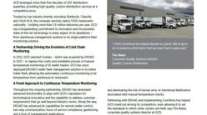Opinion: Greening Our Fleets
By Charles Arsenault
Chief Executive Officer
Arsenault Associates
This Opinion piece appears in the Oct. 10 print edition of Transport Topics. Click here to subscribe today.
There was a day when the word “green” was used mostly to describe a paint color, money or grass. Today, it has new meanings relating to the quality of the environment, our fleets’ effect upon it and the challenges fleet managers face to meet local, state and federal regulations that target everything from pollution control to managing hazardous waste.
Since commercial fleets often are identified as major sources of air pollution, using the terms “green” and “transportation industry” in the same sentence may seem contradictory to some, even oxymoronic — especially the environmentalists and government agencies who believe they can regulate and tax pollutants out of existence.
While we all would love to have zero pollutants, no amount of regulations, new taxes or good intentions will change the commercial transportation industry overnight. It is invested too heavily in — and dependent upon — current equipment, today’s infrastructure and, most of all, old habits.
Updating an entire fleet with more fuel-efficient, less-polluting vehicles is a nice idea, but it’s neither operationally nor financially practical based on someone else’s timetable.
As fleet managers, the best we can do is to keep our current fleet operating at peak performance so we don’t worsen the greenhouse gases or pollute our environment by other means — say, disregarding proper waste-disposal management, for example.
So, how do we address today’s demanding government regulations and all the media pressure to “green” our fleets?
While a fleet maintenance manager might have the mechanical tools necessary to address “black smoke” pollution issues, there is a good chance he does not have all the tools needed to control, document and administer everything required of him in today’s highly regulated operating environment.
There are other factors contributing to pollution that aren’t within the maintenance manager’s control but that affect his department — specifically drivers. These driver-related factors include excessive idling, speeding and equipment misuse, all of which have a dramatic effect on fuel consumption, related pollution and higher operating costs.
This means that dealing with pollution is a cross-departmental issue calling for cooperative integrated solutions that, if implemented well, not only will help keep our environment clean, but will preserve company profits at the same time.
Maintaining a fleet in the least costly, most effective manner today requires the close daily review and management of an enormous amount of information, including details that can be accomplished only with the help of technologies like computer software, onboard computers and the like.
Unfortunately, many fleet maintenance departments remain the weak link in the “green best practices” chain because they lack access to the same level of application-specific software and technologies typically available to other departments such as dispatch, purchasing and accounting.
Also, the mere physical presence of a computer in the fleet shop doesn’t mean it is equipped with the correct software designed to meet the fleet’s maintenance needs. After all, Word, Excel and weak data-feeder modules incorporated within accounting or purchasing programs are software, but are they really automated fleet-maintenance management systems? No, they are not.
Investing in technologies such as fleet maintenance management software, automated tire-pressure monitoring systems and GPS/automatic vehicle location (AVL) systems produces a significant, measurable and almost immediate return on investment.
What’s more, these technologies also have a direct and immediate effect on the fleet’s “green operational efficiencies” — even while preserving company profits.
No other investment a company can make will produce as large or as fast a return — or deliver as much process-enhancing productivity, cost control and pollution reduction — as technology specifically designed for fleet management.
Here are some examples of the “green-economic” results to be attained by deploying fleet technologies:
• Software that automatically documents your fleet maintenance records, inspections and schedules can mean improved scores for the Compliance, Safety, Accountability program recently introduced by the Federal Motor Carrier Safety Administration.
• Onboard computers and GPS/AVL devices can be used for purposes ranging from more efficient routing — with minimized fuel consumption and related idling time — to identifying “problem” drivers, all while increasing equipment use and reducing costs.
• Automated tire air-pressure monitoring both increases fuel mpg and reduces costs. Likewise, tire-management software will reduce physical tire-related pollution issues such as tire disposal to keep your fleet in regulatory compliance.
• Fleet software designed to help you decide whether to repair or replace vehicles and equipment will reduce fuel consumption and related greenhouse gases by automatically identifying your worst-case problem equipment.
• Software that automates preventive maintenance services scheduling based on actual use — instead of just time elapsed — will keep greenhouse gas emissions to an absolute minimum and within regulatory guidelines while also reducing downtime.
• Fleet software that specifies more efficient equipment to better meet your business applications helps extend equipment life-cycles and preserve capital.
• And fleet-specific technology in general serves to help you meet federal and state documentation requirements and eliminate fines.
Acquiring and implementing fleet technology won’t cure all fleet-related pollution on its own or eliminate finger pointing when the topic is clean air and other environmental issues, but it is a significant step in the right direction.
Lastly, the word “green” also describes the color flooding the faces of many fleet managers still holding their breath as they wait for upper management to recognize the need for modern technologies to help them maintain the company fleet at top operational levels. So, don’t wait — ask, and back up your request with this list.
Arsenault Associates is a fleet management software firm located in Burlington, N.J.



